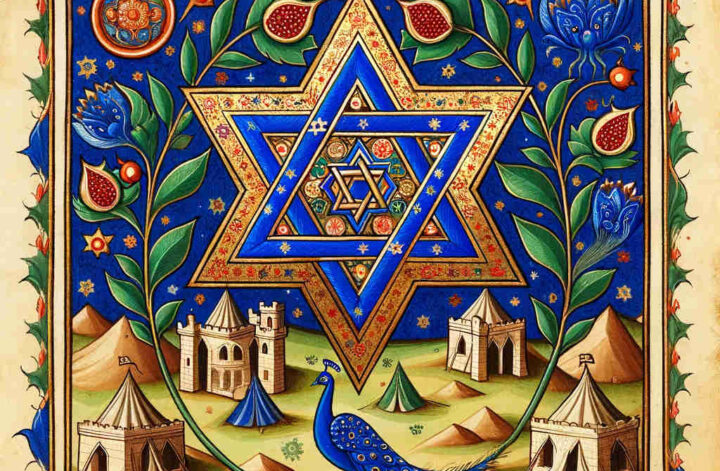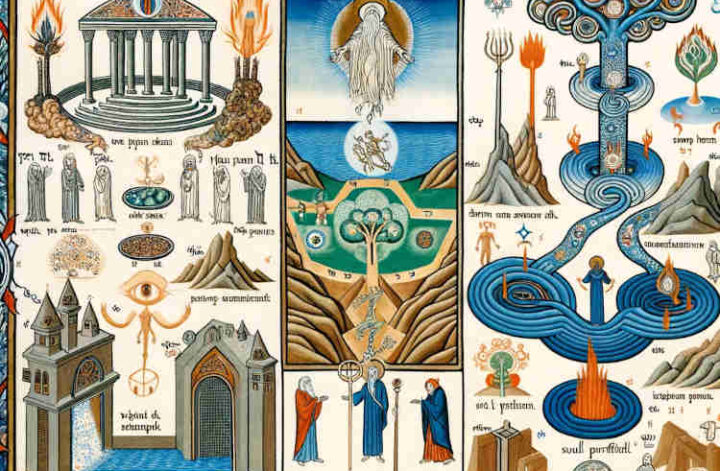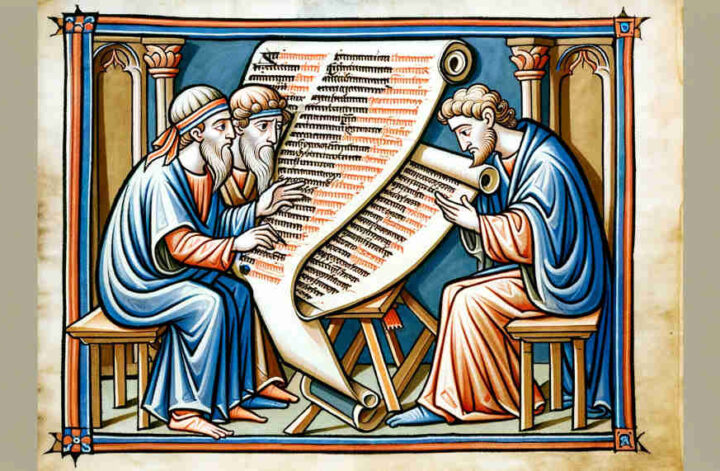Welcome to a profound journey into the heart of Jewish mysticism, where ancient wisdom meets contemporary inquiry. The Zohar, a foundational work of Kabbalistic literature, alongside the Talmud, forms the bedrock of Jewish spiritual insight. Yet, misconceptions and misunderstandings often cloud their teachings, particularly regarding human dignity and respect.
Today, we embark on a detailed exploration to dispel such misconceptions, especially those surrounding a misattributed statement to “Zohar 11b” concerning the “birth rate of non-Jews.” This article aims to illuminate the truth nestled within these sacred texts, offering clarity to those who seek it.
The Sacred Landscape of Jewish Mysticism
Jewish mysticism, or Kabbalah, presents a mystical and esoteric interpretation of Jewish teachings, encapsulated magnificently within the Zohar. Written in the late 13th century by Rabbi Moses de León, the Zohar is revered for its profound commentary on the Torah, weaving a rich tapestry of spiritual guidance, mystical insight, and ethical instruction.
Contrary to common misconceptions, the Zohar does not serve as a direct source of halachic (Jewish legal) authority akin to the Talmud. Instead, it explores the esoteric dimensions of the Torah, offering a deeper understanding of the universe, God, and the soul. The Zohar’s intricate discussions and allegorical narratives invite readers into a contemplative engagement with the divine mysteries.
“As a mirror reflects the face, so the heart of man to man. Thus, the light of the soul reflects the divine.”
Understanding the Zohar’s place within Jewish mysticism necessitates an appreciation of its historical context and spiritual objectives. It’s not merely a book but a gateway to the divine, crafted to guide the soul through the complexities of existence and toward a closer connection with the Eternal.
For those interested in delving deeper into the Zohar and Jewish mysticism, authoritative resources such as The Jewish Encyclopedia and MyJewishLearning offer valuable insights and comprehensive studies.
In our next section, we will explore the distinctions and connections between the Zohar and the Talmud, shedding light on their unique contributions to Jewish thought and spirituality. Join us as we continue to navigate through the layers of meaning and tradition, seeking to uncover the essence of Jewish ethical teachings.
Clarifying the Canon: The Zohar and Talmudic Traditions
The landscapes of Jewish spiritual and legal texts are vast and varied, with the Talmud and the Zohar standing as towering monuments of wisdom and insight. While both are indispensable to Jewish thought, they serve distinct roles that reflect the multifaceted nature of Judaism itself.
The Talmud, developed between the 3rd and 6th centuries CE, is the cornerstone of Rabbinic Judaism. It encompasses the Mishnah—Jewish oral laws—and the Gemara, a comprehensive commentary on the Mishnah. Together, they form a detailed body of law, ethics, philosophy, and history, guiding daily life and religious practice. The Talmud’s pages are a testament to the rigorous debate and discussion that shape Jewish law and morality. For an in-depth exploration of the Talmud, visit Sefaria, a free online library of Jewish texts, including the Talmud in both Hebrew and English.
In contrast, the Zohar emerges from the mystical tradition of Kabbalah in the late 13th century. Unlike the Talmud’s focus on law and ethics, the Zohar delves into the esoteric and mystical aspects of the Torah. It is written predominantly in Aramaic and structured as a commentary on the five books of the Torah, offering insights into the nature of God, the universe, and the soul. The Zohar’s teachings aim to elevate the spiritual experience of the reader, guiding them towards a mystical union with the Divine. For those seeking to delve into the mysteries of the Zohar, the Kabbalah Centre provides resources and teachings on Kabbalistic study.
Understanding the differences between these texts is crucial for appreciating their unique contributions to Jewish spirituality and law. The Talmud lays the groundwork for Jewish communal and personal life, codifying laws and ethics that have guided Jewish communities through centuries. The Zohar, with its mystical interpretations and spiritual teachings, offers a different kind of nourishment: one that seeks to connect the soul with the divine mysteries of creation.
Both texts, though different in their approach and content, are united in their goal: to deepen the understanding of the Torah and to guide the Jewish people in their spiritual and daily lives. They reflect the diversity of Jewish thought and the richness of a tradition that embraces both the legal and the mystical, the rational and the transcendental.
As we continue to explore these sacred texts, it becomes evident that a holistic understanding of Judaism requires engagement with both the legalistic discourse of the Talmud and the mystical revelations of the Zohar. This dual engagement enriches our spiritual lives and deepens our connection to the divine wisdom that permeates Jewish tradition.
“As a mirror reflects the face, so the heart of man to man. Thus, the light of the soul reflects the divine.”
The Ethical Core of Jewish Texts
At the heart of Jewish tradition lies a profound commitment to ethics, with human dignity and respect serving as central pillars. This ethical core is vividly reflected in the teachings of both the Talmud and the Zohar, despite their different focuses. The concept of b’tzelem Elohim (בצלם אלוהים), meaning ‘in the image of God,’ encapsulates the inherent value and sanctity of every human life, a theme recurrent in Jewish scholarly texts.
“He who saves one life, it is as if he saved an entire world.”
In the Talmud, this concept underpins a wide array of laws and discussions that govern how individuals interact with one another. It is a principle that demands kindness, justice, and equity, influencing legal rulings and ethical teachings alike. The Talmud’s pages are replete with debates and stories that underscore the importance of treating every person with respect and compassion, reflecting the divine image within them. For further reading on Talmudic ethics, Sefaria’s collection on ethics offers a curated selection of texts and commentaries.
Similarly, the Zohar provides a mystical perspective on human dignity, viewing each individual as a reflection of the divine light. It teaches that respecting others is akin to honoring God, for every soul is a spark of the divine. The Zohar’s mystical discourse extends the concept of b’tzelem Elohim into the realm of the cosmic, illustrating how ethical behavior and the treatment of others are interconnected with the spiritual structure of the universe. Readers interested in the Zohar’s ethical insights can explore Kabbalah Centre’s concepts and teachings, which elucidate Kabbalistic views on ethics and spirituality.
These texts, with their rich tapestry of laws, stories, and mystical teachings, collectively articulate a vision of humanity that is steeped in respect, compassion, and the pursuit of justice. They challenge us to see beyond the surface, recognizing the divine spark within each person and the ethical imperatives that this recognition entails.
The misinterpretation of sacred texts, such as the erroneous attribution of statements to “Zohar 11b,” not only distorts the teachings of Judaism but also obscures the tradition’s deep ethical commitments. By returning to the sources, and engaging with them thoughtfully and contextually, we can appreciate the true breadth and depth of Jewish ethical teaching.
Judaism’s ethical teachings, particularly those concerning human dignity, offer profound insights not only for Jews but for all humanity. They serve as a reminder of our shared responsibility to treat every individual with respect and kindness, fostering a world that reflects the divine harmony and justice envisioned by these ancient texts.
Navigating Misinterpretations
In the realm of religious texts, few challenges are as pervasive and damaging as misinterpretation. The complexity of sacred writings like the Talmud and Zohar makes them particularly susceptible to being taken out of context or misunderstood. A prime example of this issue is the misattributed statement concerning the suppression of non-Jewish birth rates, purportedly found in “Zohar 11b.” Such claims not only misrepresent the teachings of the Zohar but also fundamentally misunderstand the essence of Jewish ethical teachings.
Firstly, it is critical to note that the Zohar does not contain a page “11b” that discusses such matters. This fact alone highlights the danger of relying on secondary sources or misquoted excerpts without verifying their authenticity or context. The Zohar, a complex and symbolic text, requires careful study and interpretation, often necessitating guidance from scholars well-versed in Kabbalistic literature.
The issue of misinterpretation is not limited to malicious intent; it can also arise from a lack of familiarity with the nuances of Jewish texts. The languages of the Talmud and Zohar—Hebrew and Aramaic, respectively—contain layers of meaning and subtlety that are often lost in translation. Without a deep understanding of these languages and the historical and cultural contexts in which these texts were written, it is easy to misconstrue their messages. For those interested in learning more about the languages of Jewish texts, MyJewishLearning offers an overview of Hebrew, and Sefaria provides insights into Aramaic.
To navigate the challenges of interpretation, it is essential to engage with these texts through reputable translations and commentaries and to consult with knowledgeable scholars. This approach helps ensure that one’s understanding is grounded in the text’s true meaning and intent. Moreover, it underscores the importance of approaching sacred texts with humility and a willingness to learn, recognizing the depth and breadth of Jewish scholarship.
In addressing misinterpretations, we also confront the broader issue of how sacred texts are used in public discourse. Misquoted or decontextualized statements can fuel prejudice and misunderstanding, undermining the values of respect and compassion that are central to Jewish ethics. It is, therefore, a collective responsibility to promote accurate representations of Jewish teachings, fostering dialogue and understanding based on truth and respect.
By examining the case of the misattributed “Zohar 11b” statement, we gain insight into the critical need for careful study and the responsible dissemination of information about religious texts. In doing so, we honor the integrity of these ancient writings and the ethical teachings they espouse, contributing to a more informed and respectful discourse.
“Do not be wise in words alone, but also in understanding.”
The Path to Authentic Understanding
In the pursuit of genuine comprehension of sacred texts such as the Talmud and Zohar, the journey is as significant as the destination. The complexity and depth of these texts demand an approach grounded in respect, diligence, and an openness to the layers of meaning they contain. Achieving authentic understanding requires more than casual reading; it calls for engagement with the historical, linguistic, and philosophical contexts that shape these works.
**Reputable Translations and Commentaries**: One of the first steps on this path is to seek out reputable translations and commentaries. While direct study of the original Hebrew and Aramaic texts is ideal, it is not always feasible for everyone. High-quality translations can serve as valuable gateways to understanding, provided they are accompanied by scholarly commentaries that elucidate the text’s nuances. Resources such as Sefaria and the Kabbalah Centre offer access to a wealth of Jewish texts and their interpretations, fostering deeper insight and appreciation.
**Guidance from Knowledgeable Scholars**: Engaging with Jewish texts is a tradition that has always valued the role of teachers and scholars. Their guidance can illuminate difficult passages, resolve ambiguities, and reveal deeper meanings that might otherwise remain obscured. Seeking out such guidance, whether through formal study or informal discussion, enriches one’s understanding and connects individuals to the broader community of learners and practitioners.
**A Respectful and Humble Approach**: Approaching these texts with humility and respect is essential. The Talmud and Zohar are not merely historical documents or literary works; they are living traditions that have shaped and been shaped by generations of Jewish thought and practice. Recognizing the sacredness of these texts and the responsibility that comes with their study can transform the learning experience, opening the heart and mind to the wisdom they offer.
**Engagement with the Texts**: Authentic understanding also involves active engagement with the texts. This means not only reading but also contemplating, questioning, and discussing the ideas they present. Such engagement allows the texts to speak to the modern experience, bridging ancient wisdom and contemporary life.
The path to authentic understanding of the Talmud and Zohar is both challenging and rewarding. It invites us into a conversation that spans millennia, offering insights into the divine, the universe, and ourselves. By embracing this journey with the right tools, guidance, and mindset, we can unlock the profound wisdom contained within these sacred texts, enriching our lives and deepening our spiritual connection.
Fostering a World of Respect and Understanding
The timeless teachings of Judaism, particularly those found in the Talmud and Zohar, hold profound implications for contemporary society. At their core, these teachings emphasize the sanctity of human life, the importance of compassion, and the pursuit of justice—principles that are as relevant today as they were centuries ago. By applying these values in our daily lives, we can contribute to building a world that reflects the divine attributes of kindness, fairness, and understanding.
**The Universal Message of Dignity and Respect**: Jewish teachings assert that every human being is created b’tzelem Elohim (בצלם אלוהים), in the image of God. This concept is not just a theological assertion but a practical directive that calls for the recognition of the inherent worth and dignity of every person. In a world marked by division and conflict, this message serves as a powerful reminder of our shared humanity and the ethical obligations that flow from it.
**Challenges and Misinterpretations**: As we have seen, misinterpretations of sacred texts can lead to division and misunderstanding. Addressing these challenges requires not only correcting misconceptions but also promoting a deeper, more nuanced understanding of Jewish ethics. Education and dialogue play critical roles in this process, as they enable individuals to explore the complexities of these teachings and their applications in diverse contexts.
**Practical Applications**: The principles of respect and understanding extend to all areas of life, influencing how we interact with others, engage in community life, and address social and global issues. From the pursuit of social justice to the promotion of interfaith dialogue, Jewish teachings offer guidance on how to navigate the complexities of modern existence while staying true to ethical imperatives.
**The Role of Education**: Cultivating a world of respect and understanding begins with education. By learning from the rich tapestry of Jewish texts and traditions, individuals can gain insights into how to live ethically and contribute to the betterment of society. Educational initiatives that explore the ethical dimensions of Judaism can inspire action that is informed by compassion, justice, and a deep respect for the sanctity of life.
In conclusion, the teachings of the Talmud and Zohar provide a foundation upon which we can build a more just and compassionate world. By embracing these principles and applying them in our lives, we can foster an environment of respect and understanding that transcends cultural and religious boundaries. As we continue to navigate the challenges of the modern world, let us draw upon the wisdom of Jewish tradition to guide our way forward.
Embracing the Journey of Discovery
Our exploration of the Zohar, Talmud, and the profound ethical teachings of Judaism illuminates a path of spiritual and moral inquiry that is both ancient and urgently relevant. This journey through Jewish mysticism and ethics is not merely academic; it is a deeply personal quest for understanding, connection, and the application of divine wisdom in our lives and communities.
**The Value of Ongoing Learning**: The complexities and depths of Jewish texts like the Talmud and Zohar invite lifelong engagement. Each study session, each page turned, offers new insights and revelations, reflecting the dynamic nature of Jewish learning. The pursuit of knowledge, especially of sacred texts, is a fundamental Jewish value, encouraging not just the acquisition of information but the cultivation of wisdom and understanding.
**Dialogue and Community**: True understanding often emerges from dialogue—not only with the texts themselves but also with fellow seekers and scholars. The Jewish tradition of chevruta (חברותא), studying in pairs, exemplifies this approach, highlighting the importance of shared inquiry and the exchange of ideas. This communal aspect of study enriches our understanding and fosters a sense of belonging and connection within the tapestry of Jewish life.
**A Call to Action**: Engaging with Jewish mysticism and ethics is not an end in itself but a call to action. These teachings challenge us to look beyond the surface, to see the divine spark within each person, and to act with compassion, justice, and integrity. They inspire us to contribute to the healing of the world (tikkun olam, תיקון עולם) in whatever ways we can, guided by the wisdom of our tradition.
**Continuing the Conversation**: As we conclude this exploration, let us remember that the journey does not end here. The vast ocean of Jewish wisdom is always before us, inviting further study, reflection, and application. Let us embrace this journey with open hearts and minds, ready to discover new insights and to share them with others. In doing so, we honor the rich legacy of Jewish thought and ensure that its light continues to illuminate the path for future generations.
In the spirit of learning and growth, I encourage you to continue exploring the depths of Jewish tradition, to engage with its texts and teachings, and to join the ongoing conversation about how these ancient pearls of wisdom can inform and inspire our lives today. May your journey be filled with enlightenment, connection, and the joy of discovery.
Frequently Asked Questions
What is Zohar 11b and why is it significant?
The reference to Zohar 11b is a misunderstanding, as the Zohar does not follow the same pagination as the Talmud. The Zohar is a central work of Jewish mysticism, offering deep insights into the Torah. It’s crucial for its mystical interpretations and ethical discussions.
How does the Zohar differ from the Talmud?
The Zohar and the Talmud serve different purposes within Jewish tradition. The Talmud is a comprehensive guide to Jewish law and ethics, while the Zohar provides mystical commentary on the Torah, exploring themes of divine presence and the nature of the universe.
What are some common misconceptions about the Zohar?
Common misconceptions include the Zohar promoting negative views towards non-Jews and misinterpretations regarding its teachings on spiritual and ethical matters. It’s essential to approach the Zohar with a proper understanding of its mystical context.
Glossary of Terms
- Zohar
- The foundational work of Jewish mysticism, offering a mystical commentary on the Torah. Written in the late 13th century by Rabbi Moses de León.
- Talmud
- A central text of Rabbinic Judaism, comprising the Mishnah and the Gemara. It covers law, ethics, philosophy, customs, and history.
- Kabbalah
- A tradition of Jewish mysticism that seeks to understand the nature of God, the universe, and the soul, primarily through the study of the Zohar.
- b’tzelem Elohim (בצלם אלוהים)
- A Hebrew term meaning “in the image of God,” signifying the inherent dignity and worth of every human being.
- Mishnah
- The first major written collection of Jewish oral traditions, forming the first part of the Talmud.
- Gemara
- The component of the Talmud comprising rabbinical analysis and commentary on the Mishnah.
- Aramaic
- A semitic language closely related to Hebrew, used extensively in the Talmud and parts of the Zohar.
- Halachic
- Relating to halacha, the collective body of Jewish religious laws derived from the Written and Oral Torah.



